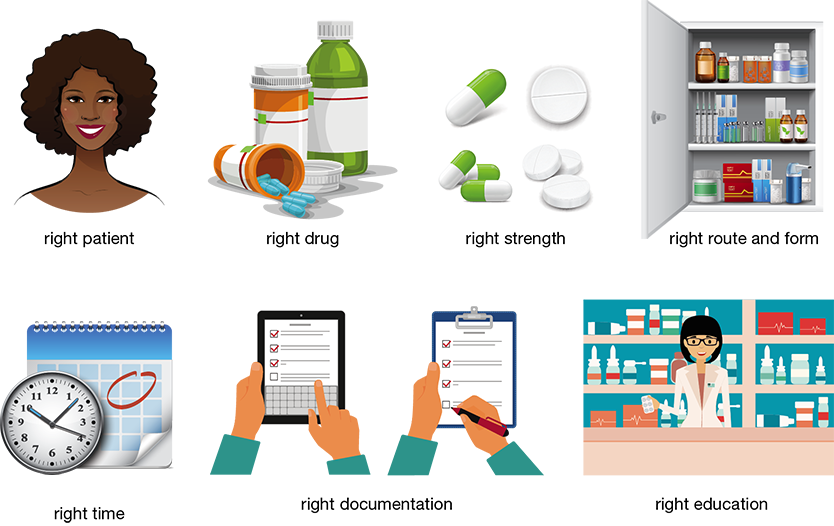14.1 Medication “Rights” and Preventable Errors
Working in health care means making a commitment to “first do no harm.” This means that healthcare workers must put safety first. As a result, no acceptable medication error rate exists, and each step in the task of filling medication orders should be reviewed with a 100% error-free goal in mind.
The Seven Prescription Rights That Patients Expect
Prescribers and pharmacy personnel are responsible for ensuring the “seven Rs,” or seven rights for the patients who trust in you (see Figure 14.1). In other words, you must work as part of a team to ensure that the medication each patient receives is for the right drug, at the right strength, in the right route formulation, for the right dosage time and supply, with the right documentation (including for insurance), for the right person, and accompanied by the right patient education.
In some ways, these rights may seem obvious, but, as you will see, errors can easily happen where the medication dispensed can be of the wrong kind; at the wrong strength; in the wrong formulation route; for the wrong dosage timing and days’ supply; with wrong or missing profile, insurance, or hospital documentation; given to the wrong person; and given without the proper patient and administration education materials.
The Scope of Medication Errors
Medication errors are one of the most common types of medical errors. The National Coordinating Council for Medication Error Reporting and Prevention (NCC MERP) defines a medication error as “any preventable event that may cause or lead to inappropriate medication use or patient harm while the medication is in the control of the healthcare professional, patient, or consumer.”
A medication error often results in an adverse drug reaction (ADR), which is an appreciably harmful or negative consequence to a patient from taking a particular drug. It may be a short-term acute reaction, long-term injury, or even death.
Figure 14.1 Patient Rights in Prescription Drug Dispensing

Medication errors are difficult to track because there are no national laws requiring the reporting of pharmacy personnel errors. Based on research, the Institute of Medicine (IOM) estimated in 2006 that more than 1.5 million medication errors cause harm in the United States every year, with deaths at about 7,000 annually. The study estimated that drug errors cause an estimated 800,000 preventable injuries in nursing homes, 400,000 in hospitals, and 500,000 among Medicare patients treated in outpatient clinics each year. Then a 2009 observational study of 50 community pharmacies found that 1.7% of prescriptions filled (4 out of 250) had an error, and an estimated 65% of these errors resulted in negative impacts on the patients’ health. Since then, no new extensive studies have been published, but a great deal of effort has been put into reducing errors by tracking where they are arising and by looking for solutions.
Medication Error Reporting Rate
In 2012, the Institute for Safe Medication Practices (ISMP) and the American Pharmacists Association (APhA) surveyed members, and 700 pharmacists from various settings responded—44% admitted making errors, and, of these, 37% admitted that they did not report the errors they made. That shows how underreported prescriptive errors are and how necessary it is for an effective check-and-balance system.

In a single operation, numerous medications are often administered to help the patient. With many different people involved, there are opportunities for miscommunication and missing some protocols, leading to medication errors.
 IN THE REAL WORLD
IN THE REAL WORLD
The October 2015 issue of Anesthesiology published an eight-month study that uncovered medication errors in almost half of all surgeries at the Harvard-affiliated Massachusetts General Hospital (MGH). Since MGH had been a leader in patient safety initiatives, especially in the operating room, this study was particularly shocking. The patients were tracked before, during, and immediately after surgery.
Out of 275 surgeries, 3,671 medication administrations were observed, with 153 medication errors discovered and 91 adverse drug events recorded. They found problems in 1 out of 20 administrations (5%). Errors arose at each stage from everyone involved, including the pharmacy department personnel. Common errors were mistakes in dosage, labeling, documentation, and neglect of proper responses to vital signs that indicated problems. Of these, 80% of the errors were considered preventable, and more than 60% of the errors caused serious effects.
Because MGH has been very proactive in safety initiatives (and continues to be so as evidenced by its willingness to be part of this study), it is estimated that the error rates at other hospitals are similar if not higher. Faced with this study information, MGH and hospitals at large are redoubling efforts to address medication errors and find the gaps in communication and procedural systems.
Cost Impact of Medication Errors
Since medication errors are underreported, it is very difficult to assess the damage. Lives are lost, and patients are disabled or lose valuable time from work or school. A 2007 study estimated that the direct and indirect costs to the healthcare system for preventable medication errors occurring inside the hospital or institutional setting were $4.2 billion and outside were $16.4 billion. These costs are primarily caused by additional hospitalizations (millions of extra days), admissions to long-term care, physician visits, and emergency room visits. Lost time at work and lost productivity must be accounted for in addition to the bereavement when individuals die.